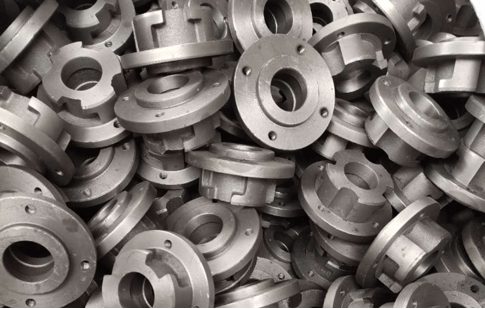Gray iron is one of the most common materials in mechanical equipment. It provides stability, vibration damping, and cost-effectiveness. QD is a caster and supplier of gray iron castings.
What is Gray Cast Iron?
Gray cast iron, also known as gray iron. Its main components include iron, carbon, and silicon.
The carbon exists as flake graphite within the metal matrix. Gray cast iron offers excellent vibration damping, wear resistance, and machinability.
Compared to other cast irons, gray iron has a mature manufacturing process and controllable cost. This makes it widely used across many industrial fields.

Characteristics of Gray Cast Iron
The performance advantages of gray cast iron come from the distribution of graphite flakes inside its structure. Let’s compare it with regular steel:
| Property | Gray Cast Iron | Regular Steel |
| Vibration Damping | Very high. Graphite flakes effectively absorb vibrations, reducing equipment noise and wear. | Relatively low. Transmits vibrations strongly, requires additional damping measures. |
| Wear Resistance | Good. Graphite flakes provide self-lubricating effect, reducing friction loss. | Depends on surface treatment or lubrication. Otherwise prone to wear. |
| Machinability | Easy to cut and form. Causes less tool wear. | Higher machining difficulty. Especially with high-temperature scrap steel. |
| Cost Effectiveness | Low material cost. Mature casting process. High overall cost performance. | Material and processing costs are typically higher. |
| Strength and Toughness | Medium tensile strength. High compressive strength, suitable for pressure-bearing components. | Both strength and toughness are relatively high. But vibration damping is insufficient. |
| Thermal Stability | Good. Suitable for environments with minimal temperature fluctuations. | Excellent. But requires adjustment based on alloy composition. |
Excellent Vibration Damping
In machine tool beds or engine blocks, gray iron components significantly reduce operational vibration. This improves equipment precision and service life. The vibration damping coefficient of gray iron is 2-3 times higher than that of steel.
Good Wear Resistance and Self-Lubrication
The graphite flakes in gray iron act as a solid lubricant during friction. This reduces direct contact between components. It is particularly suitable for frequently moving parts like guide rails, cylinder liners, and piston rings.
Good Machinability and Stability
Gray iron is easy to cut and cast. It can be quickly formed into parts with complex shapes. It has a low thermal expansion coefficient and maintains high dimensional stability under temperature changes.
Why is Gray Iron Cost-Effective?
The cost-effectiveness of gray iron is a key factor in its wide application.
Low Material Cost
Gray iron’s main raw materials are pig iron, scrap steel, and foundry returns. These materials are widely available and have stable prices. Compared to alloy steel or non-ferrous metals, gray iron has significantly lower raw material costs.
Mature Casting Process
The casting process for gray iron is simple and efficient. Most foundries use automated production lines. This enables mass production. It shortens delivery times and reduces labor costs.
High Overall Cost-Effectiveness
Although gray iron’s strength is lower than some high-end materials, its vibration damping, wear resistance, and machinability often eliminate the need for additional treatments. This means customers get high-performance parts at lower costs.
For example, in machine tool manufacturing, using gray iron beds saves the cost of vibration dampers. This reduces total cost by 20%-30%.
QD’s processes and supply chain further improve the cost-effectiveness of gray iron products. This helps customers avoid extra costs caused by quality issues.
Typical Application Scenarios
Gray iron is widely used across multiple industries due to its balanced performance and cost-effectiveness.
Machine Tool Manufacturing: Beds, guide rails, bases. Its vibration damping improves machining accuracy and extends equipment life.
Automotive Industry: Engine blocks, transmission housings, brake discs. Its wear resistance and self-lubricating properties ensure reliability of critical components.
Heavy Machinery: Pump housings, valves, gearboxes. Gray iron withstands high loads and frequent start-stop conditions.
Power Equipment: Generator bases, turbine housings. Its damping characteristics help reduce operational noise and vibration.
Daily Equipment: Compressors, agricultural machinery parts. Its cost-effectiveness makes it ideal for mass-produced goods.

In these applications, gray iron not only meets functional needs but also reduces overall costs for customers through its long service life and low maintenance requirements. QD focuses on providing customized gray iron solutions. We support clients from design to mass production, ensuring components perfectly match equipment requirements.
Manufacturing and Quality Control of Gray Iron
QD’s gray iron production typically includes the following steps:
Batching and Melting: We mix and melt pig iron, scrap steel, and alloying elements in a furnace according to composition requirements.
Casting: We pour the molten metal into molds to form the desired shapes.
Cooling and Cleaning: The castings cool in the molds. Then we clean them and remove the gates and risers.
Heat Treatment and Machining: We perform annealing or other treatments if needed to improve properties.
Quality Inspection: This includes dimensional checks, hardness testing, metallographic analysis, and non-destructive testing.

QD ensures every batch of gray iron castings meets international standards (e.g., ISO 9001). Our advantages include:
Precision testing equipment: Such as CMMs and spectrometers. This guarantees dimensional and compositional accuracy.
Process optimization: We use simulation software to predict casting defects and optimize designs in advance.
Customer collaboration: We provide full-process service from drawing review to after-sales support, ensuring customer satisfaction.
This commitment to quality has earned QD’s gray iron products a strong reputation in the industry. We not only supply standard components but can also adjust material formulas and processes based on customer needs to achieve optimal performance.
Contact Us
Need stable, vibration-damping, and cost-effective base components? Gray iron is our classic product. We have years of experience in gray iron production. We provide high-quality, customized solutions for our clients.
Whether for prototype development or mass production, we offer professional technical support and complete after-sales service. We help you improve equipment performance and reduce costs. Contact QD today to find the best solution for your gray iron castings!
FAQ
1. Is gray iron strong enough for high-load applications?
Gray iron has medium tensile strength but high compressive strength. It is suitable for pressure-bearing components. For high dynamic load conditions, performance can be improved through alloying or design optimization.
2. What are the advantages of gray iron compared to other cast irons (like ductile iron)?
Gray iron offers better vibration damping, easier machining, and lower cost. Ductile iron has higher strength but poorer vibration damping. The choice depends on specific application requirements.
3. What is the service life of gray iron components?
Under normal working conditions, gray iron components can last for decades. Their wear resistance and stability reduce maintenance needs. Our products undergo strict testing to ensure long-term reliability.
4. Does QD support customization?
Yes. We support full-process customization from drawings to finished products, including material adjustments, size modifications, and surface treatments. We provide free drawing evaluation and fast quotation services.
5. Will gray iron rust in damp environments?
Gray iron has some corrosion resistance, but surface treatment (like painting or coating) is recommended for damp or corrosive environments. We can provide protection solutions based on your application environment.
